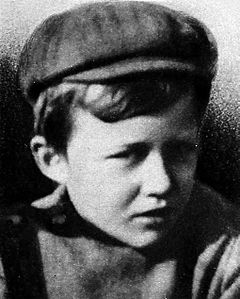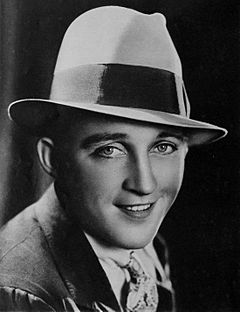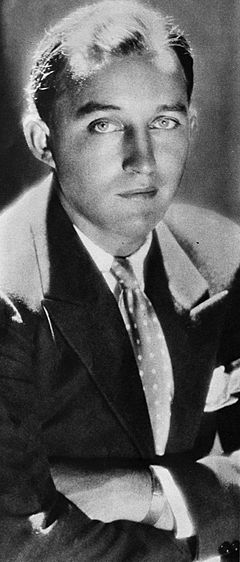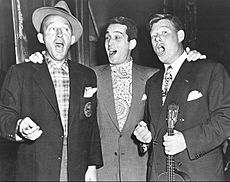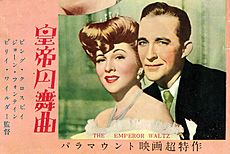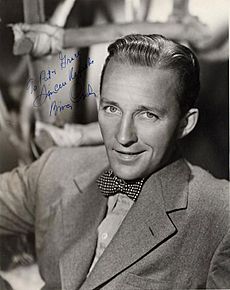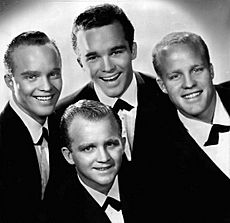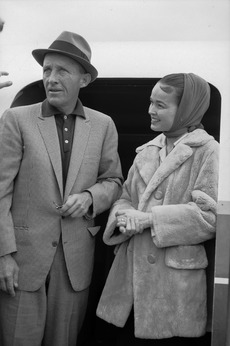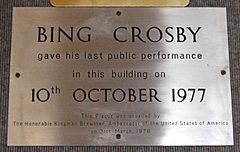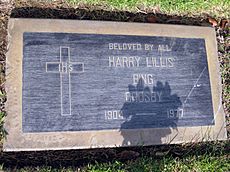Bing Crosby facts for kids
Quick facts for kids
Bing Crosby
|
|
|---|---|
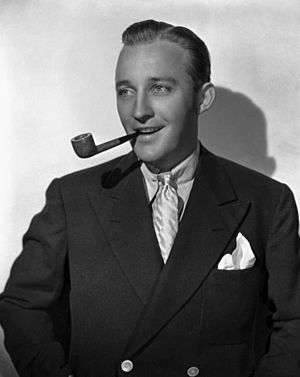
Crosby c. 1940
|
|
| Born |
Harry Lillis Crosby Jr.
May 3, 1903 Tacoma, Washington, U.S.
|
| Died | October 14, 1977 (aged 74) Alcobendas, Spain
|
| Resting place | Holy Cross Cemetery |
| Alma mater | Gonzaga University |
| Occupation |
|
| Years active | 1923–1977 |
| Spouse(s) |
|
| Children | Gary, Dennis, Phillip, Lindsay (with Dixie) Harry III, Mary, Nathaniel (with Kathryn) |
| Relatives |
|
| Musical career | |
| Genres | |
| Labels |
|
| Signature | |
 |
|
Harry Lillis "Bing" Crosby Jr. (May 3, 1903 – October 14, 1977) was a famous American singer and actor. He was one of the most popular and important musical artists of the 20th century. Bing Crosby was a huge star in record sales, radio shows, and movies from 1926 to 1977.
He was one of the first global cultural icons. He made over 70 movies and recorded more than 1,600 songs. His early singing style was quiet and personal. This way of singing influenced many famous male singers like Frank Sinatra and Elvis Presley. During World War II, Yank magazine said he helped soldiers' spirits the most. In 1948, people in America voted him the "most admired man alive."
Crosby won an Academy Award for Best Actor for his role in Going My Way (1944). He was also nominated for the movie's sequel, The Bells of St. Mary's (1945). He was the top movie star for five years in a row, from 1944 to 1948. In 1963, he received the first Grammy Global Achievement Award. He has three stars on the Hollywood Walk of Fame for movies, radio, and music. He was also well-known for his movies with his friend Bob Hope, called the Road to... films.
Crosby helped change the music recording industry after World War II. He saw a new German tape recorder and invested money to make copies of it. He was the first performer to record his radio shows and songs onto magnetic tape. This made it easier to edit and improve recordings. Bing Crosby is also famous for his song "White Christmas" from the movie Holiday Inn. Besides music, he owned television stations, bred racehorses, and was part-owner of the Pittsburgh Pirates baseball team. The team won two World Series championships while he was an owner.
Contents
- Early Life and Musical Beginnings
- Bing Crosby in Movies and TV
- Bing Crosby's Singing Style
- Amazing Career Achievements
- Global Popularity and Influence
- Bing Crosby's Business Ventures
- Bing Crosby's Family Life
- Health and Passing Away
- Bing Crosby's Legacy
- Songs Written by Bing Crosby
- Grammy Hall of Fame Awards
- Awards and Nominations
- See also
Early Life and Musical Beginnings
Bing Crosby was born on May 3, 1903, in Tacoma, Washington. In 1906, his family moved to Spokane, Washington, where he grew up. His childhood home is now a museum at Gonzaga University, showing items from his life. He was the fourth of seven children. His parents were Harry Lowe Crosby, a bookkeeper, and Catherine Helen Harrigan. His family had Irish, Scottish, and English roots.
In 1917, Crosby worked a summer job at Spokane's Auditorium. There, he saw many performers, including Al Jolson, who greatly impressed him. Crosby graduated from Gonzaga Preparatory School in 1920. He then went to Gonzaga University for three years but did not finish his degree. He played on the university's baseball team. The university later gave him an honorary degree in 1937.
Crosby got his nickname "Bing" from a neighbor around 1910. The neighbor called him "Bingo from Bingville" after a comic strip he liked. Over time, "Bingo" became "Bing."
Starting His Music Career
In 1923, Crosby joined a new band called the Musicaladers. They played at dances and on a local radio station. After two years, the band broke up. Crosby and a bandmate, Al Rinker, then got jobs at the Clemmer Theatre in Spokane. They sang between movies as part of a trio.
In 1925, Crosby and Rinker moved to Los Angeles to find more opportunities. They were hired by a show business agency for a revue called The Syncopation Idea. They earned $75 a week each. Their lively style became popular with college students. Later, they were noticed by someone from Paul Whiteman's famous orchestra.
Whiteman hired them for $150 a week in 1926. They performed with Whiteman's orchestra for the first time in Chicago. Their first recording was "I've Got the Girl" in October 1926. Crosby often said that singer Mildred Bailey helped him get his first big job in entertainment.
The Rhythm Boys and Solo Success
When Crosby and Rinker went to New York with Whiteman, they struggled at first. But then, pianist Harry Barris joined them, and they became The Rhythm Boys. This new trio could be heard better in large theaters. Crosby gained valuable experience touring and recording with famous jazz musicians. He became very popular as a solo singer.
Crosby became the main star of the Rhythm Boys. In 1928, he had his first number one hit, "Ol' Man River." In 1929, the Rhythm Boys appeared in the film King of Jazz. Soon after, Crosby decided to leave Whiteman's group. He joined the Gus Arnheim Orchestra, where his solo songs became the highlight of their shows.
In 1931, Crosby signed a solo recording contract. He also married Dixie Lee in September 1930. He then focused more on his solo career.
Becoming a Nationwide Star
Bing Crosby's solo radio show, 15 Minutes with Bing Crosby, started on September 2, 1931. This weekly show made him a nationwide hit. By the end of that year, he signed deals with both Brunswick Records and CBS Radio. Songs like "Out of Nowhere" and "At Your Command" were big sellers in 1931.
Ten of the top 50 songs of 1931 featured Crosby. He also starred in short musical films and his first full-length movie, The Big Broadcast (1932). He would appear in 79 films in total. In 1934, he signed a contract with Jack Kapp's new record company, Decca Records.
Crosby's radio show was sponsored by Cremo Cigars, which helped his fame grow. He started making three films a year for Paramount. His records sold well even during the Great Depression. Audio engineer Steve Hoffman said that Bing Crosby actually "saved the record business" in 1934. He agreed to lower the price of singles from a dollar to 35 cents, which made records more affordable.
By 1936, Crosby became the host of the weekly NBC radio program Kraft Music Hall, where he stayed for ten years. His song "Where the Blue of the Night (Meets the Gold of the Day)", with his famous whistling, became his theme song.
Crosby's singing style was different from earlier singers. He used the microphone to sing in a more personal, conversational way. This new style was called "crooning." He admired jazz musician Louis Armstrong and was influenced by his style. Crosby and Armstrong became friends and even sang together in movies. Crosby also made sure Armstrong received equal credit in films, which helped other African American artists get more opportunities.
During World War II, Crosby performed for American troops in Europe. He even learned German to read propaganda broadcasts for German forces. German listeners called him "Der Bingle," a nickname that his English-speaking fans also started using. After the war, a poll of U.S. troops showed that Crosby had done the most for their morale.
In 1945, Life magazine called Bing Crosby "America's number one star." They said he had sold 60 million records since 1931. His song "White Christmas" alone had sold 2 million copies in the U.S. and 250,000 in Great Britain by then.
The Success of "White Christmas"

Bing Crosby's biggest hit was his recording of Irving Berlin's "White Christmas." He first sang it on a Christmas Day radio show in 1941. The song appeared in his movies Holiday Inn (1942) and White Christmas (1954). His record hit the charts in October 1942 and stayed at number one for 11 weeks.
"White Christmas" became a holiday favorite and was re-released many times. It topped the charts again in 1945 and 1947. This song is still the best-selling single of all time. His recording has sold over 50 million copies worldwide. The original recording master got damaged from being used so much, so he had to re-record it in 1947. Even after Crosby passed away in 1977, the song was re-released and became a hit again in the UK.
Bing Crosby in Movies and TV
Crosby starred in many popular musical comedy films in the 1930s and 1940s. He was especially famous for the "Road to" movies with Bob Hope and Dorothy Lamour. There were six of these films between 1940 and 1962. These movies made Crosby and Hope a well-known comedy duo. They often joked about each other in a funny way. They also performed together on stage, radio, and TV many times.
In the 1949 Disney animated film The Adventures of Ichabod and Mr. Toad, Crosby narrated and sang for the "Legend of Sleepy Hollow" part. He won an Academy Award for Best Actor for Going My Way in 1944. He was also nominated for an Oscar for The Bells of St. Mary's (1945) and The Country Girl (1954).
Television Appearances
Crosby's first TV show was The Fireside Theater in 1950. These shows were filmed and then sent to TV stations to be broadcast. He often appeared as a guest on TV variety shows in the 1950s and 1960s. He also had his own popular TV specials. Bob Hope even dedicated one of his specials to their long partnership. Crosby often hosted The Hollywood Palace and appeared on its Christmas shows with his wife Kathryn and their younger children.
His last TV appearance was a Christmas special called Merrie Olde Christmas. It was filmed in London in September 1977, just weeks before he passed away. On this special, he sang a duet of "The Little Drummer Boy" and "Peace on Earth" with rock musician David Bowie. This duet became a popular holiday song and one of Crosby's last big hits.
Bing Crosby Productions, his own company, produced several TV series. These included his own sitcom The Bing Crosby Show (1964–1965). The company also produced popular shows like Ben Casey (1961–1966) and Hogan's Heroes (1965–1971).
Bing Crosby's Singing Style
Bing Crosby was one of the first singers to use the microphone to create a close, personal sound. Before him, singers had to sing very loudly to be heard in large theaters. Crosby focused on making the song's words sound real and meaningful. Music critic Henry Pleasants said Crosby brought a new "conversational ease" to American music.
Crosby's style was influenced by jazz music, especially by trumpet player Bix Beiderbecke and singer Louis Armstrong. He would bend notes and add jazz-like rhythms to his songs. He recorded with many jazz musicians like Louis Armstrong and Duke Ellington. While he was a jazz singer, he also sang in many other styles, including country, Irish, and French music.
Jack Kapp, who managed Brunswick and later Decca Records, helped Crosby try different types of songs. Crosby said Kapp helped him have number one hits in Christmas music, Hawaiian music, and country music.
Amazing Career Achievements
Bing Crosby was one of the most popular and successful musical artists of the 20th century. He had 396 songs that made it onto the music charts, including about 41 number one hits. He had charting singles every year from 1931 to 1954. In 1939 alone, he had 24 popular singles.
He was America's most successful recording artist in the 1930s and 1940s. In 1960, he was honored for selling 200 million records. Some sources say he sold 300 million or even 500 million records. His song "White Christmas" sold over 50 million copies worldwide, according to Guinness World Records.
Crosby was also a top movie star for many years. He was among the top ten actors in box-office sales for fifteen years. For five of those years (1944–1948), he was the number one star in the world. He sang four songs that won Academy Awards: "Sweet Leilani" (1937), "White Christmas" (1942), "Swinging on a Star" (1944), and "In the Cool, Cool, Cool of the Evening" (1951). He also won an Academy Award for Best Actor for Going My Way (1944).
A survey in 2000 found that Crosby was the third most popular actor of all time, based on movie tickets sold. His most popular film, White Christmas, earned $30 million in 1954.
He received 23 gold and platinum records. He also had 23 Billboard hits with The Andrews Sisters. They were his most frequent collaborators, and their partnership produced four million-selling songs, including "Pistol Packin' Mama" and "Jingle Bells".
In 1962, Crosby received the Grammy Lifetime Achievement Award. He has been added to the halls of fame for both radio and popular music. In 2007, he was inducted into the Hit Parade Hall of Fame.
Global Popularity and Influence
Bing Crosby was incredibly popular all over the world. Dorothy Masuka, a best-selling African recording artist, said that only Bing Crosby sold more records than her in Africa. His popularity there led other African singers to copy his style.
Mike Douglas, a TV presenter, shared a story from World War II. He was in Calcutta, India, and heard a man playing a record of Bing Crosby singing "Ac-Cent-Tchu-Ate The Positive." This showed how Crosby's music reached even far-off places. In India, many singers, like Kishore Kumar, were called the "Bing Crosby of India" because they imitated him.
In Europe and Russia, Crosby was also known as "Der Bingle." This nickname was given to him by an American journalist in London in 1944.
Bing Crosby's Business Ventures
Bing Crosby became one of the richest people in show business. He invested in many different things, like real estate, mines, oil wells, cattle ranches, racehorses, and baseball teams. He also made a lot of money from the Minute Maid Orange Juice Corporation, where he was a major investor.
Helping Develop Tape Recording
During the early days of radio, performers had to do their shows live. Sometimes, they even had to do the same show twice for different time zones. Bing Crosby wanted to record his radio shows beforehand. This would allow him to edit and improve them, just like making movies.
In 1945, Crosby had a disagreement with NBC because they didn't want him to pre-record his shows. He left the network for seven months. However, another network, ABC, was willing to let him record his shows. Crosby offered to pay for the development of new recording machines.
He invested $50,000 in a company called Ampex. In 1947, Crosby started recording his radio show, Philco Radio Time, using a German-made tape recorder. The new Ampex machines and magnetic tape allowed for much better sound quality and easier editing.
Bing Crosby helped start the tape recorder revolution in America. He even gave one of the first Ampex recorders to his friend, guitarist Les Paul. This led to Les Paul inventing multitrack recording, which allows musicians to record different parts of a song separately and then combine them. Crosby's company also developed things like the laugh track, which is still used today.
Investing in Television
Crosby also helped develop videotape technology. Early television shows were mostly live, but Crosby wanted to be able to record them, just like his radio shows. In 1951, Bing Crosby Enterprises showed the world's first videotape recording in Los Angeles. The images were a bit blurry at first, but it was a big step forward.
Crosby also owned television stations. In 1954, a group led by Crosby bought station KCOP-TV in Los Angeles. He also helped start the CBS television station in his hometown of Spokane, Washington.
Horse Racing and Sports
Crosby loved horse racing. He bought his first racehorse in 1935. In 1937, he helped start the Del Mar Thoroughbred Club in California. He and his friend Lindsay Howard formed the Binglin Stable to race and breed horses. A famous race in 1938 at Del Mar featured Crosby's horse Ligaroti against the legendary Seabiscuit.
Crosby was also a big sports fan. From 1946 until his death, he owned a part of the Pittsburgh Pirates baseball team. He was so nervous during Game 7 of the 1960 World Series that he listened to it on the radio in Paris instead of watching. The Pirates won that game with a famous walk-off home run. Crosby had the game recorded on film, which was later found in his wine cellar in 2009 and shown on TV.
Crosby was also a very good golfer. He started playing at age 12 as a caddy. He hosted the first 'Crosby Clambake' golf tournament in 1937. This event is now known as the AT&T Pebble Beach Pro-Am and is a popular tournament on the PGA Tour. In 1978, he was inducted into the World Golf Hall of Fame.
Bing Crosby's Family Life
Bing Crosby was married twice. His first wife was actress and singer Dixie Lee. They were married from 1930 until she passed away in 1952. They had four sons: Gary, twins Dennis and Phillip, and Lindsay.
After Dixie Lee's death, Crosby married actress Kathryn Grant in 1957. They had three children: Harry Lillis III, Mary Frances, and Nathaniel.
The Crosby family lived in the San Francisco area for many years. In 1963, Bing and Kathryn moved their three young children from Los Angeles to a large estate in Hillsborough, California. They wanted to raise their children outside of Hollywood.
Sadly, four of Bing's sons from his first marriage passed away at relatively young ages. Lindsay died in 1989, Dennis in 1991, Gary in 1995, and Phillip in 2004.
His son Nathaniel Crosby became a high-level golfer. In 1981, he won the U.S. Amateur at age 19, becoming the youngest winner at that time. His daughter Mary Crosby is an actress, known for her role on the TV show Dallas. His granddaughter Denise Crosby is also an actress, known for Star Trek: The Next Generation.
Health and Passing Away
In 1974, Bing Crosby recovered from a serious lung infection. After that, he started making new albums and doing concerts again. On March 20, 1977, after filming a TV special, Crosby fell off the stage and hurt his back.
In September 1977, Crosby, his family, and singer Rosemary Clooney went on a concert tour in Britain. While there, he recorded his last album, Seasons, and his final TV Christmas special with guest David Bowie. His very last concert was in Brighton, England, on October 10, just four days before he passed away. The next day, he made his final recording in a studio.
On October 13, 1977, Crosby flew to Spain to play golf. On October 14, after playing 18 holes of golf, he was walking back to the clubhouse. He said, "That was a great game of golf, fellas. Let's go have a Coca-Cola." These were his last words. He then collapsed and passed away instantly from a heart attack. He was 74 years old.
Bing Crosby was buried at Holy Cross Cemetery in Culver City, California.
Bing Crosby's Legacy
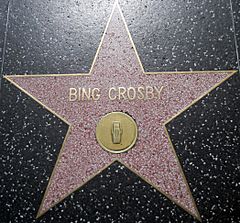
Bing Crosby is a member of the National Association of Broadcasters Hall of Fame for radio. His family created an official website in 2007, on the 30th anniversary of his death.
His friend Bob Hope wrote in his book, "Dear old Bing, as we called him, the Economy-sized Sinatra. And what a voice. God I miss that voice."
A calypso musician named Roaring Lion wrote a tribute song to Bing Crosby in 1939, saying Crosby had a way of singing "with his very heart and soul."
Bing Crosby Stadium in Front Royal, Virginia was named after him because he helped raise money for its construction. In 2006, a theater in his hometown of Spokane, Washington, was renamed The Bing Crosby Theater.
Crosby has three stars on the Hollywood Walk of Fame. One for his work in radio, one for his recordings, and one for his motion pictures.
Songs Written by Bing Crosby
Crosby wrote or helped write the lyrics for 22 songs. His song "At Your Command" was number one on the U.S. pop singles chart for three weeks in 1931. "I Don't Stand a Ghost of a Chance with You" was his most successful song as a writer. It was recorded by many famous artists like Duke Ellington and Frank Sinatra.
Some songs co-written by Crosby include:
- "That's Grandma" (1927)
- "From Monday On" (1928)
- "At Your Command" (1931)
- "Where the Blue of the Night (Meets the Gold of the Day)" (1931)
- "I Don't Stand a Ghost of a Chance with You" (1932)
- "Love Me Tonight" (1932)
- "Waltzing in a Dream" (1932)
- "That's What Life is All About" (1975)
Grammy Hall of Fame Awards
Four of Bing Crosby's performances have been added to the Grammy Hall of Fame. This special award honors recordings that are at least 25 years old and are very important historically or for their quality.
| Bing Crosby: Grammy Hall of Fame | |||||
| Year Recorded | Title | Genre | Label | Year Inducted | Notes |
|---|---|---|---|---|---|
| 1942 | "White Christmas" | Traditional Pop (single) | Decca | 1974 | With the Ken Darby Singers |
| 1944 | "Swinging on a Star" | Traditional Pop (single) | Decca | 2002 | With the Williams Brothers Quartet |
| 1936 | "Pennies from Heaven" | Traditional Pop (single) | Decca | 2004 | With the Jimmy Dorsey Orchestra |
| 1944 | "Don't Fence Me In" | Traditional Pop (single) | Decca | 1998 | With the Andrews Sisters |
Awards and Nominations
| Year | Award | Category/Status | Project/Team | Result |
|---|---|---|---|---|
| 1944 | New York Film Critics Circle Awards | Best Actor | Going My Way | Won |
| 1944 | Photoplay Awards | Most Popular Male Star | — | Won |
| 1945 | — | Won | ||
| 1945 | Academy Awards | Best Actor in a Leading Role | Going My Way | Won |
| 1946 | Photoplay Awards | Most Popular Male Star | — | Won |
| 1946 | Academy Awards | Best Actor in a Leading Role | The Bells of St. Mary's | Nominated |
| 1947 | Photoplay Awards | Most Popular Male Star | — | Won |
| 1948 | — | Won | ||
| 1952 | Golden Globes | Best Motion Picture Actor | Here Comes the Groom | Nominated |
| 1954 | National Board of Review | Best Actor | The Country Girl | Won |
| 1955 | Academy Awards | Best Actor in a Leading Role | Nominated | |
| 1960 | Golden Globe Awards | Golden Globe Cecil B. DeMille Award | — | Won |
| 1960 | Hollywood Walk of Fame | Radio | 6769 Hollywood Blvd. | Inducted |
| 1960 | Recording | 6751 Hollywood Blvd. | Inducted | |
| 1960 | Motion Picture | 1611 Vine Street. | Inducted | |
| 1960 | 1960 World Series | Co-owner | Pittsburgh Pirates | Won |
| 1963 | Grammy Lifetime Achievement Award | Won | ||
| 1970 | Peabody Awards | Personal Award | — | Won |
| 1971 | 1971 World Series | Co-owner | Pittsburgh Pirates | Won |
See also
 In Spanish: Bing Crosby para niños
In Spanish: Bing Crosby para niños


